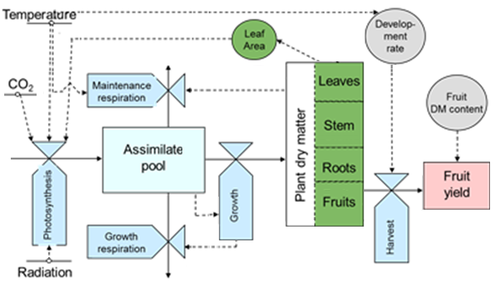Preliminary Course.
Plant and crop Models
Plant and Crop model typology
Descriptive Versus Causal Models
-
In climate and fertilization control, forestry, plant and crop production studies, etc. , two types of models are widely used: descriptive ones, and explanatory ones.
- These are built using various approaches: black box, regression, statistical, empirical, etc.
- They try to build direct relations between input and output. They reflect few or none of the mechanisms that cause the behaviour of the system.
- These are based on physiological, mechanistic or structural concepts.
- They define quantitative descriptions of the underlying mechanisms and processes.
- They contain sub-models at least one hierarchical level deeper than the response to be described. At the lowest hierarchical level, sub-models in an explanatory model are descriptive and the model's ability to explain is limited by its number of hierarchical levels.
-
Descriptive models
Example.
An experiment carried out on young tomato plants after 40 days of growth at Wageningen University in a climate chamber.
In the following table, the respective columns stand for average daily temperature, average nightly temperature and plant height.
| Tday (°C) | Tnight (°C) | Plant height (cm) |
| 26 | 16 | 52 |
| 24 | 18 | 50 |
| 22 | 20 | 34 |
| 20 | 22 | 35 |
| 18 | 24 | 28 |
| 16 | 26 | 23 |
| 18 | 18 | 18 |
| 24 | 24 | 54 |
| 24 | 12 | 39 |
A statistical model can be defined from these data:
Height = 36.3 + 4.48 * (Tday-21) + 1.37 * (Tnight-21)
Explanatory (causal) models
An example of a mechanistic model.

A mechanistic crop model scheme described according to Foresster diagrams.
The arrows show information pathways while processes are represented in blue containers.
In the light blue rectangle, the biomass pool fed by the leaf area and allocated to the plant organs (in green). (Chart courtesy of E. Heuvelink, WAGENINGEN UNIVERSITY)
